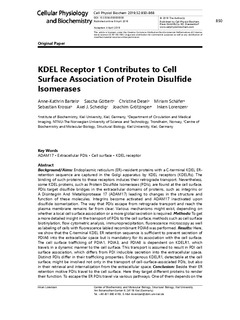| dc.description.abstract | Background/Aims: Endoplasmic reticulum (ER)-resident proteins with a C-terminal KDEL ER-retention sequence are captured in the Golgi apparatus by KDEL receptors (KDELRs). The binding of such proteins to these receptors induces their retrograde transport. Nevertheless, some KDEL proteins, such as Protein Disulfide Isomerases (PDIs), are found at the cell surface. PDIs target disulfide bridges in the extracellular domains of proteins, such as integrins or A Disintegrin And Metalloprotease 17 (ADAM17) leading to changes in the structure and function of these molecules. Integrins become activated and ADAM17 inactivated upon disulfide isomerization. The way that PDIs escape from retrograde transport and reach the plasma membrane remains far from clear. Various mechanisms might exist, depending on whether a local cell surface association or a more global secretion is required. Methods: To get a more detailed insight in the transport of PDIs to the cell surface, methods such as cell surface biotinylation, flow cytometric analysis, immunoprecipitation, fluorescence microscopy as well as labeling of cells with fluorescence labled recombinant PDIA6 was performed. Results: Here, we show that the C-terminal KDEL ER retention sequence is sufficient to prevent secretion of PDIA6 into the extracellular space but is mandatory for its association with the cell surface. The cell surface trafficking of PDIA1, PDIA3, and PDIA6 is dependent on KDELR1, which travels in a dynamic manner to the cell surface. This transport is assumed to result in PDI cell surface association, which differs from PDI inducible secretion into the extracellular space. Distinct PDIs differ in their trafficking properties. Endogenous KDELR1, detectable at the cell surface, might be involved not only in the transport of cell-surface-associated PDIs, but also in their retrieval and internalization from the extracellular space. Conclusion: Beside their ER retention motive PDIs travel to the cell surface. Here they target different proteins to render their function. To escape the ER PDIs travel via various pathways. One of them depends on the KDELR1, which can transport its target to the cell surface, where it is to be expected to release its cargo in close vicinity to its target molecules. Hence, the KDEL sequence is needed for cell surface association of PDIs, such as PDIA6. | nb_NO |

